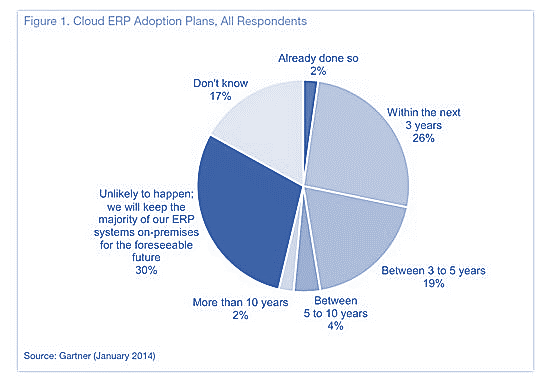
Is Cloud ERP (Enterprise Resource Planning) software the best option to replace aging ERP systems? The simple answer: It depends. For some CIOs and CTOs this will be a question of paramount importance. The rates of adoption are indicative of certain types of companies favoring cloud options.
Louis Columbus, a contributor to Business to Community and Forbes, published an article about cloud ERP adoption rates being faster than previously predicted. Gartner’s study, Survey Analysis: Adoption of Cloud ERP 2013 through 2023, published on January 24, of this year, advises CIOs to look at cloud ERP for replacement of aging systems.
After surveying companies ranging in size from $10M to $10B, Gartner found that 47% of the organizations plan on moving their core ERP systems to the cloud within five years.

These core functions were focused more on administration, financials, human capital management and procure to pay than manufacturing functions though. This means, manufacturing companies will have to seriously consider if cloud options are and will be ideal in the future. On-premises might can often be a better option for manufacturing intensive ERP functions. In fact, 30% of respondents said that the majority of their ERP systems will remain on-premises. Almost all in this group were in the manufacturing sector.
Many manufacturers are considering a two-tier ERP strategy. says Epicor, a Datix ERP partner, “as a way to modernize their systems and maintain data integrity and efficiency across the enterprise.” And these organizations are opting to implement two-tier ERP solutions at the division or site level, while maintaining a legacy ERP system at the headquarters level. This two-tiered system allows you to keep your on-premises ERP while equipping your other locations or subsidiaries with cloud based options. This gives you visibility into other branches at a reasonable cost.
Why consider a two-tier ERP strategy?
- Cloud ERP can be deployed twice as fast as in-house systems.
- It is easier to customize a solution for each of your subsidiaries.
- Reduce costs of TCO, which some studies place at 50% the cost of on-premises applications.
- Get more visibility with built-in dashboards for oversight of your other locations.
Suggested
- More blogs by Matt Schuval
- The Datix Blog
- Epicor Consulting
- Learn more about Datix ERP consulting services

